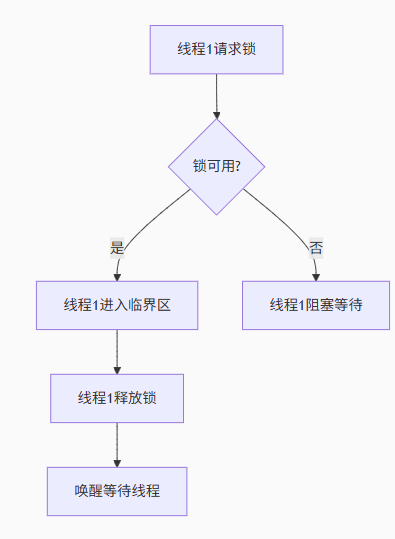引言:并发编程的挑战
在多线程编程中,资源竞争是开发者面临的核心挑战。当多个线程同时访问共享资源(如变量、文件、数据库连接等)时,可能导致数据不一致、程序崩溃或不可预测的行为。Python的全局解释器锁(GIL)虽然在一定程度上简化了线程安全,但并不能解决所有并发问题。互斥锁(Mutex) 作为并发编程的基石,提供了确保线程安全的可靠机制。
本文将深入探讨Python中互斥锁的实现原理、使用模式、性能优化和实战应用,通过原创代码示例和深度分析,帮助您掌握构建健壮并发系统的核心技术。
第一部分:互斥锁基础理论
1.1 互斥锁的核心概念
互斥锁(Mutual Exclusion Lock)是一种同步原语,用于保护共享资源,确保在任何时刻只有一个线程可以访问临界区。其基本操作包括:
-
获取锁(acquire):线程请求对资源的独占访问权
-
释放锁(release):线程释放资源控制权
-
阻塞等待:当锁被占用时,其他请求线程进入等待状态

1.2 竞争条件与数据损坏
考虑以下未使用锁的银行账户操作:
class UnsafeAccount:
def __init__(self, balance):
self.balance = balance
def withdraw(self, amount):
if amount <= self.balance:
# 模拟处理延迟
time.sleep(0.001)
self.balance -= amount
return True
return False
# 测试代码
account = UnsafeAccount(1000)
def concurrent_withdraw():
for _ in range(100):
account.withdraw(1)
# 创建10个线程同时取款
threads = []
for _ in range(10):
t = threading.Thread(target=concurrent_withdraw)
threads.append(t)
t.start()
for t in threads:
t.join()
print(f"最终余额: {account.balance}") # 预期为0,实际通常大于0
这种数据不一致就是典型的竞争条件导致的结果。
1.3 Python的threading.Lock
Python标准库提供了简单易用的锁实现:
import threading
class SafeAccount:
def __init__(self, balance):
self.balance = balance
self.lock = threading.Lock()
def withdraw(self, amount):
with self.lock: # 自动获取和释放锁
if amount <= self.balance:
time.sleep(0.001)
self.balance -= amount
return True
return False
使用with语句可以确保锁的正确释放,即使在临界区代码抛出异常的情况下。
第二部分:高级锁机制
2.1 可重入锁(RLock)
普通锁在同一个线程中不可重入,会导致死锁:
lock = threading.Lock()
def recursive_func(count):
with lock:
if count > 0:
recursive_func(count-1) # 再次尝试获取锁,导致死锁
# 使用RLock解决
rlock = threading.RLock()
def safe_recursive(count):
with rlock: # 同一线程可多次获取
if count > 0:
safe_recursive(count-1)
2.2 条件变量(Condition)
条件变量用于线程间的复杂协调:
class TaskQueue:
def __init__(self, max_size):
self.tasks = []
self.max_size = max_size
self.cond = threading.Condition()
def add_task(self, task):
with self.cond:
# 等待队列有空位
while len(self.tasks) >= self.max_size:
self.cond.wait()
self.tasks.append(task)
self.cond.notify() # 通知消费者
def get_task(self):
with self.cond:
# 等待任务可用
while len(self.tasks) == 0:
self.cond.wait()
task = self.tasks.pop(0)
self.cond.notify() # 通知生产者
return task
2.3 信号量(Semaphore)
信号量用于控制对有限资源的访问:
class ConnectionPool:
def __init__(self, max_connections):
self.pool = []
self.sem = threading.Semaphore(max_connections)
def get_connection(self):
self.sem.acquire() # 减少可用资源计数
# 实际实现中会返回或创建连接
return "connection"
def release_connection(self, conn):
# 返回连接池
self.sem.release() # 增加可用资源计数
第三部分:锁的内部实现原理
3.1 Python锁的源码解析
Python的锁实现基于底层操作系统的同步原语。在Unix系统上,主要使用pthread mutex;在Windows上使用CRITICAL_SECTION。以下是简化版的Lock实现原理:
class PyLock:
def __init__(self):
self._lock = 0 # 0表示未锁定,1表示已锁定
self.waiters = [] # 等待队列
def acquire(self, blocking=True):
"""获取锁的核心逻辑"""
if not blocking and self._lock:
return False
while True:
# 原子操作检查并设置锁状态
if self._compare_and_swap(0, 1):
return True
if not blocking:
return False
# 将当前线程加入等待队列
self._add_waiter()
# 挂起线程,等待唤醒
def release(self):
"""释放锁的核心逻辑"""
self._lock = 0
# 唤醒一个等待线程
if self.waiters:
waiter = self.waiters.pop(0)
self._wake_waiter(waiter)
def _compare_and_swap(self, expected, new):
"""原子操作:比较并交换"""
# 实际使用底层原子指令实现
if self._lock == expected:
self._lock = new
return True
return False
3.2 全局解释器锁(GIL)的影响
GIL是CPython解释器中的全局锁,它确保任何时候只有一个线程执行Python字节码。这影响了多线程程序的性能特性:
| 场景 | GIL影响 | 建议方案 |
|---|---|---|
| CPU密集型任务 | 多线程无法利用多核 | 使用多进程 |
| I/O密集型任务 | 阻塞I/O操作会释放GIL | 多线程有效 |
| C扩展操作 | 可显式释放GIL | 使用NumPy等优化库 |
# 演示GIL释放场景
import time
def cpu_bound():
# 计算密集型任务,受GIL限制
sum = 0
for i in range(10**7):
sum += i
def io_bound():
# I/O操作会释放GIL
time.sleep(1)
第四部分:死锁分析与预防
4.1 死锁的四个必要条件
-
互斥:资源不能共享
-
持有并等待:线程持有资源同时请求新资源
-
不可剥夺:资源只能由持有者释放
-
循环等待:线程间形成等待环路
4.2 常见死锁场景与解决方案
场景1:嵌套锁顺序不一致
lockA = threading.Lock()
lockB = threading.Lock()
# 线程1
with lockA:
with lockB:
# 操作资源
# 线程2
with lockB: # 与线程1顺序相反
with lockA:
# 操作资源
解决方案:固定锁的获取顺序
场景2:未释放锁的异常
lock = threading.Lock()
def risky_operation():
lock.acquire()
try:
# 可能抛出异常的操作
raise ValueError("意外错误")
finally:
lock.release() # 必须确保释放
解决方案:使用with语句或try-finally
4.3 死锁检测与恢复
实现简单的死锁检测器:
class DeadlockDetector:
def __init__(self):
self.lock_graph = defaultdict(set)
self.detection_lock = threading.Lock()
def register_acquire(self, thread, lock):
with self.detection_lock:
# 添加边:线程 -> 锁
self.lock_graph[thread].add(lock)
# 检查是否有循环
if self._has_cycle(thread):
self._handle_deadlock(thread)
def register_release(self, thread, lock):
with self.detection_lock:
if lock in self.lock_graph[thread]:
self.lock_graph[thread].remove(lock)
def _has_cycle(self, start):
"""使用DFS检测循环"""
visited = set()
stack = [start]
while stack:
node = stack.pop()
if node in visited:
return True
visited.add(node)
stack.extend(self.lock_graph[node])
return False
def _handle_deadlock(self, thread):
# 实际应用中可能记录日志、中断线程等
print(f"检测到死锁! 线程: {thread.name}")
# 中断当前线程(谨慎使用)
# threading.current_thread().interrupt()
第五部分:锁的性能优化
5.1 锁性能分析工具
使用cProfile分析锁竞争:
import cProfile
import threading
lock = threading.Lock()
shared_data = 0
def worker():
global shared_data
for _ in range(100000):
with lock:
shared_data += 1
# 性能分析
profiler = cProfile.Profile()
profiler.enable()
threads = [threading.Thread(target=worker) for _ in range(4)]
for t in threads:
t.start()
for t in threads:
t.join()
profiler.disable()
profiler.print_stats(sort='cumtime')
5.2 降低锁竞争策略
策略1:减小临界区范围
# 不推荐:整个函数在锁内
def process_data(data):
with lock:
result = complex_computation(data)
store_to_database(result)
# 推荐:仅保护共享资源
def optimized_process(data):
result = complex_computation(data) # 在锁外执行耗时计算
with lock:
store_to_database(result) # 仅保护数据库访问
策略2:使用读写锁
import threading
class ReadWriteLock:
"""读写锁实现"""
def __init__(self):
self._read_ready = threading.Condition(threading.Lock())
self._readers = 0
def acquire_read(self):
with self._read_ready:
self._readers += 1
def release_read(self):
with self._read_ready:
self._readers -= 1
if self._readers == 0:
self._read_ready.notify_all()
def acquire_write(self):
self._read_ready.acquire()
while self._readers > 0:
self._read_ready.wait()
def release_write(self):
self._read_ready.release()
策略3:无锁数据结构
import threading
class LockFreeCounter:
"""基于原子操作的无锁计数器"""
def __init__(self):
self._value = threading._allocate_lock()
self.value = 0
def increment(self):
while True:
# 使用CAS(比较并交换)原子操作
current = self.value
new = current + 1
if self._compare_and_swap(current, new):
return new
def _compare_and_swap(self, expected, new):
# 模拟原子操作(实际使用CPU指令)
if self.value == expected:
self.value = new
return True
return False
结语:锁的艺术与哲学
互斥锁作为并发编程的基础工具,其使用既是一门技术,也是一门艺术。在Python并发编程中,我们需要:
-
理解场景:区分CPU密集型和I/O密集型任务
-
合理选择:根据需求选择锁、队列、Actor等并发模型
-
最小化竞争:减小临界区、使用读写锁、避免不必要的同步
-
预防死锁:固定锁顺序、使用超时、避免嵌套锁
-
优先高级抽象:使用Queue、线程池等高级工具减少直接锁操作
"并发不是并行,但并行需要并发。锁不是目的,安全才是根本。" —— 并发编程箴言
随着Python生态的发展,asyncio、multiprocessing等模块提供了更多并发选择。但无论技术如何演进,理解互斥锁的原理和应用,始终是构建可靠并发系统的基石。




















 328
328

 被折叠的 条评论
为什么被折叠?
被折叠的 条评论
为什么被折叠?








